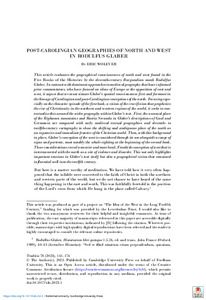Post-Carolingian Geographies of North and West in Rodulfus Glaber
| dc.date.accessioned | 2024-04-15T10:47:53Z | |
| dc.date.available | 2024-04-15T10:47:53Z | |
| dc.date.issued | 2023-12-14 | |
| dc.identifier | doi:10.17170/kobra-202404159987 | |
| dc.identifier.uri | http://hdl.handle.net/123456789/15660 | |
| dc.description.sponsorship | Gefördert im Rahmen des Projekts DEAL | |
| dc.language.iso | eng | |
| dc.rights | Namensnennung 4.0 International | * |
| dc.rights.uri | http://creativecommons.org/licenses/by/4.0/ | * |
| dc.subject | west | eng |
| dc.subject | Rodulfus Glaber | ger |
| dc.subject | north | eng |
| dc.subject | geography | eng |
| dc.subject | cartography | eng |
| dc.subject | Europe | eng |
| dc.subject | history writing | eng |
| dc.subject.ddc | 900 | |
| dc.title | Post-Carolingian Geographies of North and West in Rodulfus Glaber | eng |
| dc.type | Aufsatz | |
| dcterms.abstract | This article evaluates the geographical consciousness of north and west found in the Five Books of the Histories by the eleventh-century Burgundian monk Rodulfus Glaber. In contrast with dominant approaches to medieval geography that have informed prior commentators, who have focused on ideas of Europe or the opposition of east and west, it argues that we must situate Glaber's spatial consciousness first and foremost in the lineage of Carolingian and post-Carolingian conceptions of the north. Focusing especially on the climactic episode of the first book, a vision of the crucifixion that prophesies the rise of Christianity in the northern and western regions of the world, it seeks to contextualize this around the wider geography within Glaber's text. First, the unusual place of the Riphaean mountains and Raetia Secunda in Glaber's descriptions of Gaul and Germania are compared with early medieval textual geographies and eleventh- to twelfth-century cartography to show the shifting and ambiguous place of the north as an expansive and immediate frontier of the Christian world. Then, with this background in place, Glaber's conception of the west is considered through its use alongside a range of signs and portents, most notably the whale sighting at the beginning of the second book. These considerations reveal a messier and more local, Frankish conception of west that is interconnected with the north as a site of violence and disorder. This not only highlights important tensions in Glaber's text itself, but also a geographical vision that remained influential well into the twelfth century. | eng |
| dcterms.accessRights | open access | |
| dcterms.creator | Wolever, Eric | |
| dc.relation.doi | doi:10.1017/tdo.2023.1 | |
| dc.subject.swd | Europa | ger |
| dc.subject.swd | Rodolfus, Glaber | ger |
| dc.subject.swd | Kartografie | ger |
| dc.subject.swd | Geografie | ger |
| dc.type.version | publishedVersion | |
| dcterms.source.identifier | eissn:2166-5508 | |
| dcterms.source.journal | Traditio | ger |
| dcterms.source.pageinfo | 141 - 174 | |
| dcterms.source.volume | Volume 78 | |
| kup.iskup | false |
Dateien zu dieser Ressource
Das Dokument erscheint in:
-
Artikel [1109]


